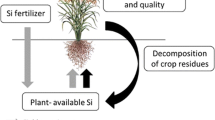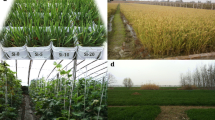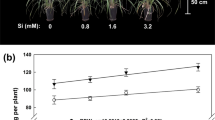Abstract
Background and aim
Silicon is known to be able to substitute carbon in plant biomass, especially in cellulose, lignin and phenols. However, a more comprehensive picture regarding the effect of silicon accumulation on plant carbon quality (cellulose, lignin, phenol, wax, lipids, and free organic acids content) with regard to potential decomposability is still missing.
Methods
Two different rice varieties (French brown and red rice cultivars) were cultivated under five different soil silicon availabilities. After maturity we harvested the plants and analyzed them regarding carbon quality by FTIR spectroscopy and regarding plant silicon concentrations.
Results
Silicon accumulation was found to be dependent on silicon availability and on the specific rice cultivar. The lowering of carbon compounds content by silicon was found not to be restricted to cellulose, lignin and phenol. Silicon accumulation was able to decrease other carbon compounds such as fat, wax, lipids, and free organic acids, too.
Conclusions
Consequently, silicon is important for the carbon quality of silicon accumulating plants. Furthermore, silicon accumulation in plants is interfering with a large range of different carbon compounds potentially altering the leaf economic spectra, decomposability, and thus potentially interfering with the whole performance of ecosystems dominated by silicon accumulating plant species.


Similar content being viewed by others
References
Agarie S, Uchida H, Agata W, Kubota F, Kaufman PB (1998) Effects of silicon on transpiration and leaf conductance in rice plants (Oryza sativa L.). Plant Production Science 1:89–95
Agethen S, Knorr K-H (2018) Juncus effusus mono-stands in restored cutover peat bogs–analysis of litter quality, controls of anaerobic decomposition, and the risk of secondary carbon loss. Soil Biol Biochem 117:139–152
Artz RR, Chapman SJ, Robertson AJ, Potts JM, Laggoun-Défarge F, Gogo S, Comont L, Disnar J-R, Francez A-J (2008) FTIR spectroscopy can be used as a screening tool for organic matter quality in regenerating cutover peatlands. Soil Biol Biochem 40:515–527
Awmack CS, Leather SR (2002) Host plant quality and fecundity in herbivorous insects. Annu Rev Entomol 47:817–844
Bogdan K, Schenk MK (2008) Arsenic in rice (Oryza sativa L.) related to dynamics of arsenic and silicic acid in paddy soils. Environ Sci Technol 42:7885–7890
Broadley M, Brown P, Cakmak I, Ma JF, Rengel Z, Zhao F (2012) Chapter 8 - beneficial elements. In: Marschner P (ed) Marschner's mineral nutrition of higher plants (third edition). Academic Press, San Diego
Cocozza C, D'orazio V, Miano T, Shotyk W (2003) Characterization of solid and aqueous phases of a peat bog profile using molecular fluorescence spectroscopy, ESR and FT-IR, and comparison with physical properties. Org Geochem 34:49–60
Coûteaux M-M, Bottner P, Berg B (1995) Litter decomposition, climate and litter quality. Trends Ecol Evol 10:63–66
DeMaster DJ (1981) The supply and accumulation of silica in the marine environment. Geochim Cosmochim Acta 45:1715–1732
Dobermann A, Fairhurst T (2000) Rice: nutrient disorders & nutrient management. Int. Rice Res, Inst
Eberle A (2015) Arsen im roten Reis der Camargue, Bayreuth
Epstein E (1999) Silicon. Annu Rev Plant Physiol Plant Molec Biol 50:641–664
Hodgkins SB, Richardson CJ, Dommain R, Wang HJ, Glaser PH, Verbeke B, Winkler BR, Cobb AR, Rich VI, Missilmani M, Flanagan N, Ho M, Hoyt AM, Harvey CF, Vining SR, Hough MA, Moore TR, Richard PJH, De la Cruz FB, Toufaily J, Hamdan R, Cooper WT, Chanton JP (2018) Tropical peatland carbon storage linked to global latitudinal trends in peat recalcitrance. Nat Commun 9
Hodson MJ, White PJ, Mead A, Broadley MR (2005) Phylogenetic variation in the silicon composition of plants. Ann Bot 96:1027–1046
Klotzbücher T, Klotzbücher A, Kaiser K, Vetterlein D, Jahn R, Mikutta R (2018) Variable silicon accumulation in plants affects terrestrial carbon cycling by controlling lignin synthesis. Glob Change Biol 24:e183–e189
Li Z, Song Z, Parr JF, Wang H (2013) Occluded C in rice phytoliths: implications to biogeochemical carbon sequestration. Plant Soil 370:615–623
Li Z, Song Z, Cornelis J-T (2014) Impact of rice cultivar and organ on elemental composition of phytoliths and the release of bio-available silicon. Front Plant Sci 5:529
Li Z, Song Z, Singh BP, Wang H (2019) The impact of crop residue biochars on silicon and nutrient cycles in croplands. Sci Total Environ 659:673–680
da Luz BR (2006) Attenuated total reflectance spectroscopy of plant leaves: a tool for ecological and botanical studies. New Phytol 172:305–318
Ma JF, Takahashi E (2002) Soil, fertilizer, and plant silicon research in Japan. Elsevier
Ma JF, Yamaji N (2015) A cooperated system of silicon transport in plants. Trends Plant Sci 20:435–442
Ma J, Nishimura K, Takahashi E (1989) Effect of silicon on the growth of rice plant at different growth stages. Soil Sci Plant Nutr 35:347–356
Ma JF, Tamai K, Ichii M, Wu GF (2002) A rice mutant defective in Si uptake. Plant Physiol 130:2111–2117
Ma JF, Tamai K, Yamaji N, Mitani N, Konishi S, Katsuhara M, Ishiguro M, Murata Y, Yano M (2006) A silicon transporter in rice. Nature 440:688–691
Meharg C, Meharg AA (2015) Silicon, the silver bullet for mitigating biotic and abiotic stress, and improving grain quality, in rice? Environ Exp Bot 120:8–17
Meunier JD, Keller C, Guntzer F, Riotte J, Braun JJ, Anupama K (2014) Assessment of the 1% Na2CO3 technique to quantify the phytolith pool. Geoderma 216:30–35
Meyer-Jacob C, Vogel H, Boxberg F, Rosén P, Weber ME, Bindler R (2014) Independent measurement of biogenic silica in sediments by FTIR spectroscopy and PLS regression. J Paleolimnol 52:245–255
Neu S, Schaller J, Dudel EG (2017) Silicon availability modifies nutrient use efficiency and content, C:N:P stoichiometry, and productivity of winter wheat (Triticum aestivum L.). Sci Rep 7:40829
Niemeyer J, Chen Y, Bollag J-M (1992) Characterization of humic acids, composts, and peat by diffuse reflectance Fourier-transform infrared spectroscopy. Soil Sci Soc Am J 56:135–140
Ninno C, Dorosh PA (2001) Averting a food crisis: private imports and public targeted distribution in Bangladesh after the 1998 flood. Agric Econ 25:337–346
Rawsthorne S (2002) Carbon flux and fatty acid synthesis in plants. Prog Lipid Res 41:182–196
Richmond T (2000) Higher plant cellulose synthases. Genome Biol 1:reviews3001. 3001
Samuels L, Kunst L, Jetter R (2008) Sealing plant surfaces: cuticular wax formation by epidermal cells. Annu Rev Plant Biol 59:683–707
Sauer D, Saccone L, Conley DJ, Herrmann L, Sommer M (2006) Review of methodologies for extracting plant-available and amorphous Si from soils and aquatic sediments. Biogeochemistry 80:89–108
Savant N, Snyder G, Datnoff L (1996) Silicon management and sustainable rice production. Adv Agron 58:151–199
Schaller J, Brackhage C, Dudel E (2012a) Silicon availability changes structural carbon ratio and phenol content of grasses. Environ Exp Bot 77:283–287
Schaller J, Brackhage C, Gessner MO, Bäuker E, Gert Dudel E (2012b) Silicon supply modifies C:N:P stoichiometry and growth of Phragmites australis. Plant Biol 14:392–396
Schaller J, Brackhage C, Paasch S, Brunner E, Bäucker E, Dudel EG (2013) Silica uptake from nanoparticles and silica condensation state in different tissues of Phragmites australis. Sci Total Environ 442:6–9
Schaller J, Hines J, Brackhage C, Bäucker E, Gessner MO (2014) Silica decouples fungal growth and litter decomposition without changing responses to climate warming and N enrichment. Ecology 95:3181–3189
Schaller J, Hodson MJ, Struyf E (2017) Is relative Si/ca availability crucial to the performance of grassland ecosystems? Ecosphere 8:e01726
Schaller J, Wang J, Islam MR, Planer-Friedrich B (2018) Black carbon yields highest nutrient and lowest arsenic release when using rice residuals in paddy soils. Sci Rep 8
Schoelynck J, Bal K, Backx H, Okruszko T, Meire P, Struyf E (2010) Silica uptake in aquatic and wetland macrophytes: a strategic choice between silica, lignin and cellulose? New Phytol 186:385–391
Snyder G (2001) Methods for silicon analysis in plants, soils, and fertilizers. Studies in Plant Science 8:185–196
Song Z, Liu H, Strömberg CA, Yang X, Zhang X (2017) Phytolith carbon sequestration in global terrestrial biomes. Sci Total Environ 603:502–509
Vogel H, Meyer-Jacob C, Thöle L, Lippold JA, Jaccard SL (2016) Quantification of biogenic silica by means of Fourier transform infrared spectroscopy (FTIRS) in marine sediments. Limnol Oceanogr Methods 14:828–838
Wright IJ, Reich PB, Westoby M, Ackerly DD, Baruch Z, Bongers F, Cavender-Bares J, Chapin T, Cornelissen JHC, Diemer M, Flexas J, Garnier E, Groom PK, Gulias J, Hikosaka K, Lamont BB, Lee T, Lee W, Lusk C, Midgley JJ, Navas ML, Niinemets U, Oleksyn J, Osada N, Poorter H, Poot P, Prior L, Pyankov VI, Roumet C, Thomas SC, Tjoelker MG, Veneklaas EJ, Villar R (2004) The worldwide leaf economics spectrum. Nature 428:821–827
Yamaji N, Ma JF (2007) Spatial distribution and temporal variation of the rice silicon transporter Lsi1. Plant Physiol 143:1306–1313
Zhu Y-G, Williams PN, Meharg AA (2008) Exposure to inorganic arsenic from rice: a global health issue? Environ Pollut 154:169–171
Acknowledgements
We are grateful to Johannes Stemper for help during plant cultivation, Cyrille Thomas (Centre Français du Riz) for providing the soil and discussion on cultivation practices, Stefan Will for ICP-MS and Central Analytics (all University of Bayreuth) for ICP-OES measurements. FTIR spectra were recorded at the central laboratory of the Institute of Landscape Ecology, University of Münster. The help of Henning Teickner in evaluation of FTIR spectra is greatly acknowledged.
Author information
Authors and Affiliations
Corresponding author
Additional information
Responsible Editor: Yong Chao Liang.
Publisher’s note
Springer Nature remains neutral with regard to jurisdictional claims in published maps and institutional affiliations.
Electronic supplementary material
ESM 1
(DOC 3795 kb)
Rights and permissions
About this article
Cite this article
Schaller, J., Heimes, R., Ma, J.F. et al. Silicon accumulation in rice plant aboveground biomass affects leaf carbon quality. Plant Soil 444, 399–407 (2019). https://doi.org/10.1007/s11104-019-04267-8
Received:
Accepted:
Published:
Issue Date:
DOI: https://doi.org/10.1007/s11104-019-04267-8




